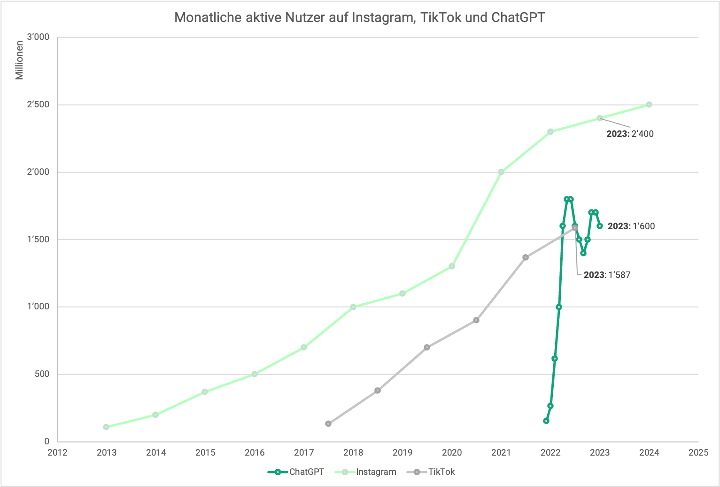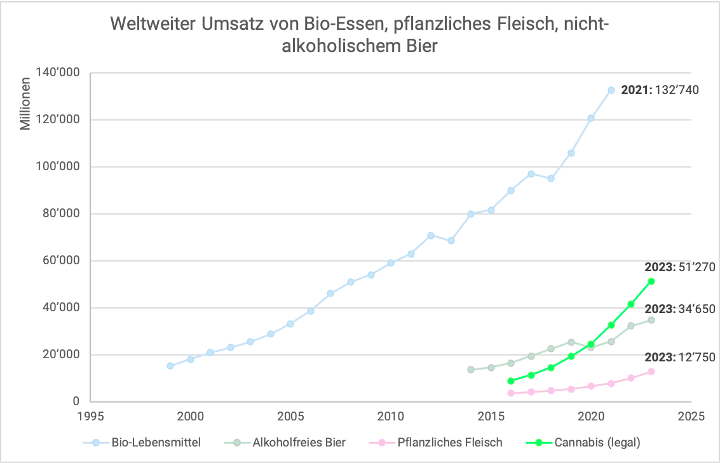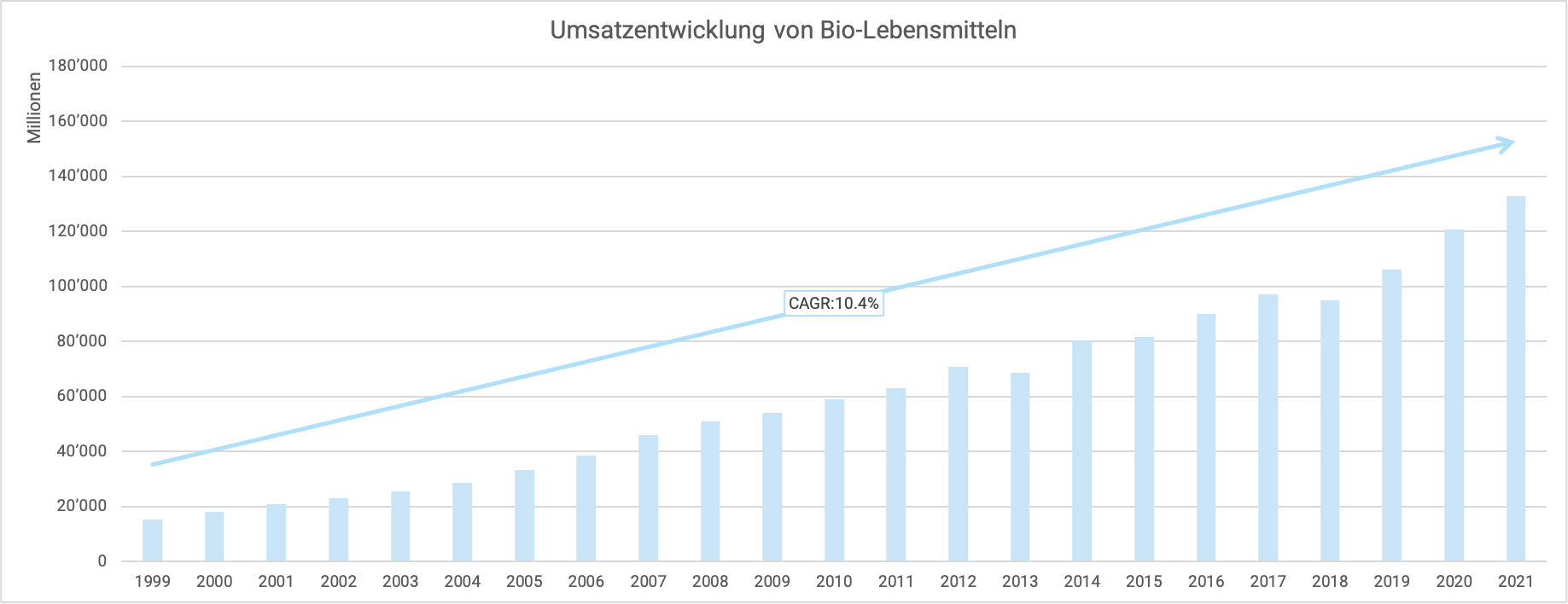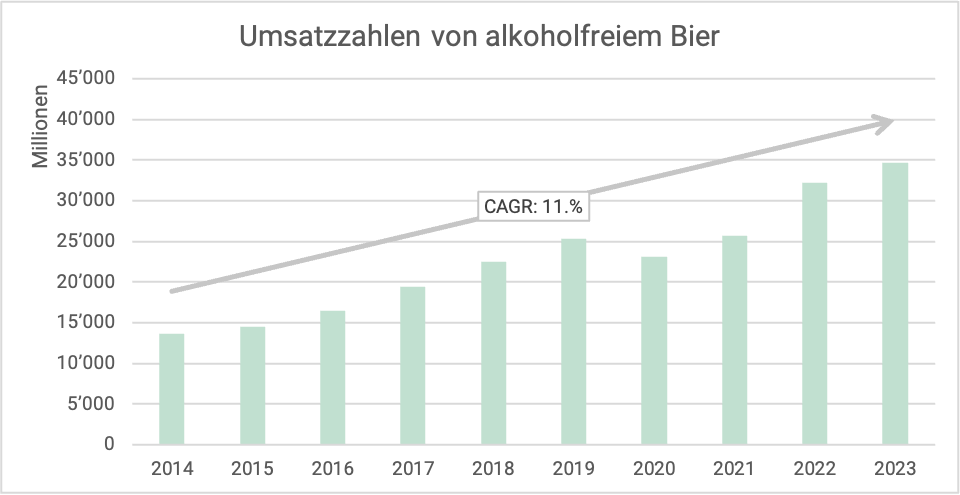Autor: Davide Brunetti
Whether it’s ChatGPT, TikTok or Instagram, the successes of the tech industry characterise expectations and set the pace of innovation by which other industries measure themselves. However, each industry has a different innovation dynamic. The GDI has analysed how long it takes for food innovations to establish themselves on the mass market and what the main differences are compared to the innovation dynamics in the tech industry.

Figure 1: Number of monthly active users on Instagram, TikTok and ChatGPT. These applications have average annual growth rates of 23.1% (Instagram), 64.2% (TikTok) and an astonishing 775% (ChatGPT) , which far exceed the usual product growth rates in other industries.
Clear differences can be identified using the food industry as an example. We have analysed the growth rates of several product categories, all of which have attracted a great deal of media attention in recent years. These categories are organic food, non-alcoholic beer, plant-based meat and cannabis products. Although these categories are not radical (product) innovations, ongoing hype can be observed about all of these categories. Innovation in this context should therefore be understood as a change in consumer perceptions. As a result of this change, values, preferences and consumer habits also change. This is referred to as cultural innovation. However, a look at the growth figures for these product categories leaves a feeling of disillusionment.

Figure 2: Consumption of organic food is growing at an annual average rate of 10.4% (measured since 1999), non-alcoholic beer at an annual average rate of 11% (since 2014), plant-based meat at an annual average rate of 19.7% (since 2016) and cannabis products at an annual average rate of 28.4% (since 2016). It should be noted that these figures do not reflect the introduction to the market of the respective products, but only the available data. It should also be noted that there can be considerable differences in organic standards depending on the country, and that these products are therefore not necessarily comparable with each other. You can find more information about this issue here. Finally, it should be mentioned that the sales figures for cannabis represent strictly legalised products. Furthermore, the sales figures for cannabis include three types of use: recreational, medical and therapeutic. More information can be found here.
Whereas switching to a new, better or trendier social media platform hardly requires any great effort, and can sometimes be done with just a few mouse clicks, things are very different in the food industry. This difference is due to a variety of factors, such as price, availability or flavour. However, we would like to focus on one factor that is absolutely central: culture. Food innovations try to change behaviour that is already deeply rooted in our culture and to which we usually adhere more strongly than to internet platforms.
Food is about more than the product, nutrient density and calorific content. Food is a cultural asset. It's not just about what you eat, but also how, where and with whom. We also pay more for a “slow” meal in a fine-dining restaurant than for fast food. Accordingly, it is not enough to simply offer a lower-calorie, more environmentally friendly or simply cheaper product for it to gain mass acceptance. If such products are well received, it is often because they are driven by subliminal cultural movements.
Food innovations therefore have a much harder time than the tech innovations in the example above. Food innovations are forced to swim against the mainstream tide. Although plant-based meat and legal cannabis products have shown considerable growth rates, they cover comparatively smaller markets. They have been able to corner market niches, but not the overall market. Nevertheless, the acceptance of these products is indicative of a cultural change: it begins in subcultures that are slowly but steadily spreading. Instagram, TikTok and ChatGPT, all of which have more than 1.5 billion monthly active users, prove that their use does not require a cultural shift; the current global culture is already attuned to the offerings of these applications. Plant-based meat, (legal) cannabis products and certainly non-alcoholic beer, all of which challenge deeply rooted consumption norms, fail to achieve this astonishing reach in a short space of time.
Organic food reflects a slow success story that is increasingly establishing itself in the mainstream: Bio Suisse was launched in 1981. Its organic products now account for a market share of 11.2% of the total range of products available in Switzerland. The situation is similar for the German organic food company Alnatura, which has successfully established itself in 14 different European countries since it was founded in 1984. However, the growth rates remain modest when compared with the aforementioned tech innovations: global sales of organic food grew at an average annual rate of 10.4% between 1999 and 2021.
In the food industry, it is therefore not enough to launch a faster, more (nutritionally) efficient or cheaper product on the market to win over customers. Instead, it needs more understanding of the cultural factors behind our eating habits. You can find out more about this topic at this year's International Food Innovation Conference.
Sources:
- https://www.demandsage.com/instagram-statistics
- https://explodingtopics.com/blog/chatgpt-users
- https://www.businessofapps.com/data/tik-tok-statistics
- https://www.statista.com/statistics/273090/worldwide-sales-of-organic-foods-since-1999
- https://www.statista.com/forecasts/1091389/non-alcoholic-beer-market-size-worldwide
- https://www.statista.com/forecasts/877369/global-meat-substitutes-market-value (source collected: 2 February 2024)
- https://www.statista.com/outlook/hmo/cannabis/worldwide#revenue






